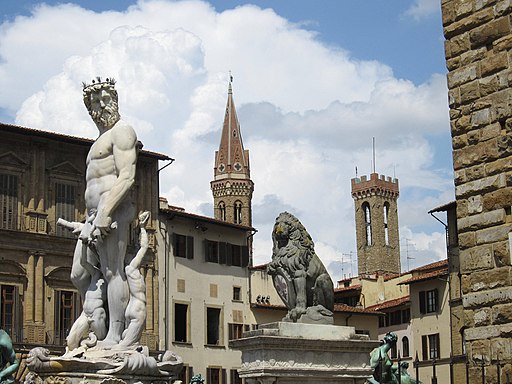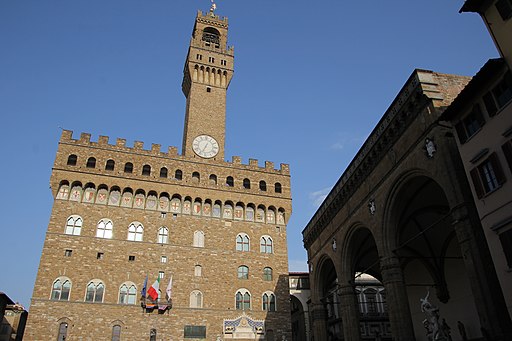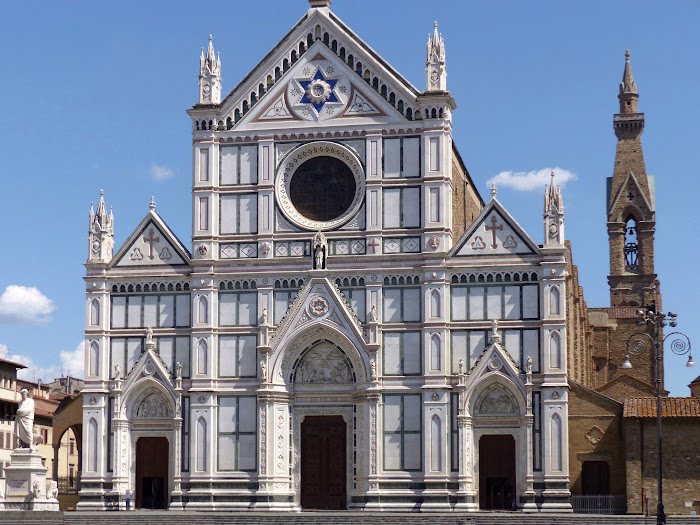| |
|
The Loggia dei Lanzi or Loggia della Signoria is a sculpture gallery in the Piazza della Signoria in Firenze. The gallery was built between 1376 and 1382 by Benci di Cione and Simone Talenti and is effectively an open-air sculpture gallery of antique and Renaissance art.
'More than any other piazza in Italy, the Piazza della Signoria evokes the antique world. (...) Some are antique Greek and Roman; some are Renaissance; some belong to the Mannerist epoch; one to the nineteenth century. Yet there is no disharmony among them; they seem all of a piece, one continuous experience, a coin periodically reminted. It is a sanguinary world they evoke.'
In the background in the Loggia are five marble statues of women (three are identified as Matidia, Marciana and Agrippina Minor, and a statue of the barbarian prisoner Thusnelda from Roman times from Trajan to Hadrian). They were discovered in Rome in 1541. The statues had been in the Medici villa in Rome since 1584 and were brought to Florence in 1789 [3].
Ulpia Marciana (August 48 – 112) was the beloved elder sister of Roman Emperor Trajan. She was the eldest child born to Roman woman Marcia and the Roman senator Marcus Ulpius Traianus. Her second name Marciana she inherited from her mother’s paternal ancestors. After 105, her brother awarded her with the title of Augusta.
Marciana married Gaius Salonius Matidius Patruinus. Patruinus was a wealthy man, who served as a praetor and later became a senator. Patruinus died in 78 and Marciana never remarried. After Patruinus’ death, Marciana and Matidia went to live with Trajan and his wife.
Trajan, who was childless, treated his niece Matidia as if she were his own daughter.
Agrippina minor (ca. 15 - 59) also took an active part in dynastic politics and would also give political advice to her husband Claudius and her son Nero.
|
|
|
Thusnelda, (details), Romens beeld in de Loggia dei Lanzi, Piazza della Signoria [0]
|
The statues were discovered in Rome and were in the Capranica della Valle collection as early as 1541, a collection that was completely purchased by Cardinal Ferdinando I de 'Medici in 1584, after which the statues were moved to the Villa Medici in Rome. Since 1787 they belong to the 'Medici collection in Firenze, in 1789 they were placed under the Loggia dei Lanzi.
Thusnelda
Thusnelda (c. 10 BC – unknown) was a Germanic noblewoman who was captured by the Roman general Germanicus during his invasion of Germania. She was the wife of Arminius. Tacitus and Strabo cite her capture as evidence of both the firmness and restraint of Roman arms.
Thusnelda was the daughter of the pro-Roman Cheruscan prince Segestes. In 9 AD, Arminius, Thusnelda's future husband, led a coalition of Germanic tribes that defeated the legions of Publius Quinctilius Varus at the Battle of the Teutoburg Forest. The conflict between the Roman Empire and the Germanic tribes continued after the Battle of the Teutoburg Forest, and Arminius abducted and impregnated Thusnelda circa 14 AD, likely as a result of a dispute with her pro-Roman father.[1]
In May 15 AD, Thusnelda was captured by Germanicus, who commanded the invasion of Germania. She was pregnant and staying with her father, who had seized her from Arminius at some point. It was Segestes who delivered her to Germanicus, after the latter saved the former by driving off Arminius' forces, who had besieged Segestes.[2] Arminius grieved his loss of Thusnelda deeply and did not marry again.[3] According to Tacitus, Arminius was "driven to frenzy" by the loss of his wife.[4][5]
|
| During her captivity, Thusnelda gave birth to her and Arminius' only child, Thumelicus. At the Battle of the Weser River, Arminius engaged in a famous disputation with his brother Flavus, who was still serving in the Roman army. Flavus informed Arminius that Thusnelda was being well-treated — as, he claimed, was typical of Rome. On May 26, 17 AD, Thusnelda and her son Thumelicus were displayed as prized trophies of the triumph granted to Germanicus. During the triumphal parade, her father was forced to watch from the stands.[6] Contemporary historians evince discomfort with her display as evidence of Roman victory in Germania, as Arminius had resisted capture.[7]
Thusnelda's son, Thumelicus, was trained at the gladiator school in Ravenna and is believed to have died in a gladiator show at a young age. Tacitus wrote that he would report on Thumelicus' fate "at the proper time" — i.e., when he discussed the year in question in his chronicle.[8] The main gap in the text of the Annals is for 30 and 31 AD, so it could be that Thumelicus died then, aged 15 or 16.
Details of Thusnelda's life after the triumph of 17 AD and her date of death are unknown.
|
|

Statue of a Barbarian prisoner, so-called Thusnelda”. Marble, Roman artwork of the period of Trajan or Hadrian (2nd century CE) with modern restorations. Found in Rome; in the Capranica della Valle Collection, 1541; at the Villa Medicis in Rome, 1584; in Florence since 1787, installed at the Loggia dei Lanzi in 1789.
|
| |
|
|
 |
|
 |
|
 |
Ulpia Marciana (48 AD - 112 AD)
elder sister of Roman Emperor Trajan |
|
Salonia Matidia (68 AD - 119 AD)
daughter and only child of Ulpia Marciana and wealthy praetor Gaius Salonius Matidius Patruinus |
|
Agrippina Minor, (Cologne 15 AD - Misenum 59). Roman Empress and one of the more prominent women in the Julio-Claudian dynasty |
|

|
Il cosiddetto "Gruppo di Pasquino" (di cui sono noti diversi esemplari), rappresenta, si pensa, Menelao che sorrege il corpo di Patroclo. Marmo, copia romana di età flavia da un originale ellenistico del III sec. a.C., con restauri moderni. Scoperto a Roma; dal 1584 di proprietà medicea a Firenze; collocato sotto la Loggia dei Lanzi in Piazza della Signoria a Firenze sin dal 1741. [9]
|
The most famous statues under the Loggia dei Lanzi are:
The Rape of the Sabine Women (Giambologna, 1583)
Hercules and the Centaur (Giambologna, 1599)
Perseus and Medusa (Benvenuto Cellini, 1554)
The robbery of Polyxena (Pio Fedi)
Menelaos by the body of Patroclus
|
 |
|
 |
|
 |
| De Sabijnse maagdenroof, Giambologna, 1583 |
|
Benvenuto Cellini, Perseo con la testa di Medusa
|
|
Giambologna, Hercules verslaat de centaur Nessus (1599), Loggia dei Lanzi, Piazza della Signoria, Firenze
|
 |
|
 |
|
 |
Il Gruppo di Pasquino, (Patroclo e Menelao), 1599, Loggia dei Lanzi, Piazza della Signoria, Firenze
|
|
Pio Fedi, De roof van Polyxena |
|
Mercurio. Calco moderno della statuetta di Benvenuto Cellini in una nicchia della base del Perseo, nella Loggia dei Lanzi di Firenze. L'originale è esposto al Museo del Bargello a Firenze. Foto di Giovanni Dall'Orto. |
|
|
|
|
| |
|
Piazza della Signoria, Firenze, photo gallery
|
|
|
 |
|
 |
|
 |
Fontana del Nettuno, Piazza della Signoria, Firenze |
|
Equestrian statue of Cosimo I de 'Medici in the Piazza della Signoria in Firenze
|
|
Baccio Bandinelli, la statua Ercole e Caco, con sfondo la Galleria degli Uffizi |
 |
|
 |
|
 |
Loggia dei Lanzi, Piazza della Signoria
|
|
Hercules andCacus (Baccio Bandinelli) Loggia dei Lanzi, Piazza della Signoria, Firenze
|
|
Fontana del Nettuno e campanili Badia e Bargello. Accanto alla fontana, su un piedistallo, c'è il Marzocco, il leone che è un importante simbolo per Firenze
|
 |
|
 |
|
 |
Palazzo Vecchio, Loggia dei Lanzi, Piazza della Signoria, Firenze
|
|
Fontana del Nettuno, Piazza della Signoria, Firenze |
|
Michelangelo, David (replica), Piazza della Signoria, Firenze
|

|
|
|
 |
|
![Piazzale Michelangelo [Magnificent View on Ponte Vecchio]](https://upload.wikimedia.org/wikipedia/commons/thumb/4/4f/Florence_from_Piazzale_Michelangelo_-_panoramio_%286%29.jpg/512px-Florence_from_Piazzale_Michelangelo_-_panoramio_%286%29.jpg) |
|
 |
Firenze, Basilica di Santa Croce, facciata
|
|
Piazzale Michelangelo [Magnificent View on Ponte Vecchio] |
|
Piazzale Michelangelo, con veduta del Duomo di Santa Maria del Fiore |
| |
|
|
|
|
| |
|
|
|
|
 |
|
|
|
|
| |
|
|
|
|
Art in Tuscany | The Loggia della Signoria | The Loggia dei Lanzi
Tacito, Annales. (testo latino  , traduzione italiana e traduzione inglese). , traduzione italiana e traduzione inglese).
|
|
|
| |
|
|
Bibliography
Le statue della Loggia della Signoria a Firenze. Capolavori restaurati, a cura di G. Giusti Galardi, Firenze, Giunti, 2002.
C. Paolini, La Loggia dei Lanzi. Una storia per immagini, Quaderno n. 15, Polistampa, Firenze, 2006.
Mary McCarthy, The Stones of Florence, Harcourt Brace International (1998), ISBN-10: 9780156850803 - ISBN-13: 978-0156850803
McHam, Sarah Blake. "Donatello's Bronze David and Judith as Metaphors of Medici Rule in Florence." The Art Bulletin 83, no. 1 (March 2001): 32-47. Accessed September 20, 2013.
|

[0] Foto di Sailko, licenziato in base ai termini della licenza Creative Commons Attribuzione-Condividi allo stesso modo 4.0 Internazionale
[1] Tacitus, The Annals 1.55
[2] Tacitus, The Annals 1.57
[3] Thusnelda, Wife of Hermann". www.germanamericanpioneers.org. Retrieved 2019-06-01.
[4] Arminius". Ancient History Encyclopedia. Retrieved 2019-06-01.
[5] Foto di Gianni Careddu, licenziato in base ai termini della licenza Creative Commons Attribuzione-Condividi allo stesso modo 4.0 Internazionale.
[6] Strabo, Geography, VII.4.33–38. | www.perseus.tufts.edu/
Strabo. ed. H. L. Jones, The Geography of Strabo. Cambridge, Mass.: Harvard University Press; London: William Heinemann, Ltd. 1924.
[7] Beard, Mary (2007). The Roman Triumph. The Belknap Press of Harvard University Press. p. 107.
[8] Tacitus, The Annals 1.58
[9] Foto di Gianni Careddu, licenziato in base ai termini della licenza Creative Commons Attribuzione-Condividi allo stesso modo 4.0 Internazionale.
|
° This article incorporates material from the Wikipedia article Thusnelda, published under the GNU Free Documentation License. |
|
|